
James Nizam Celestial Telegraphies
Berlin 10 Sep – 7 Nov 2020
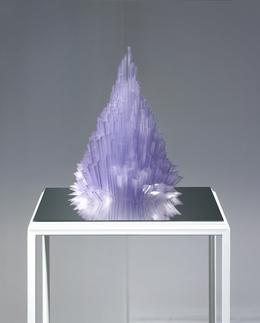
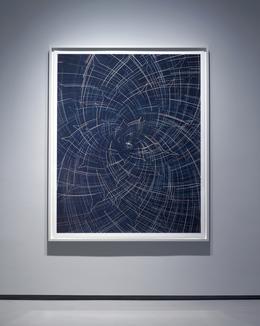
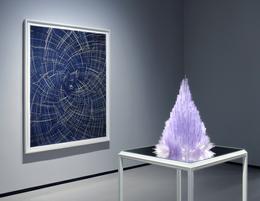
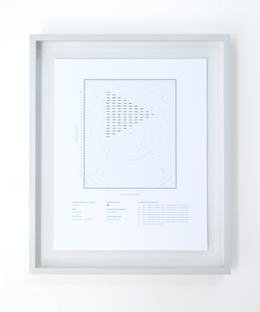
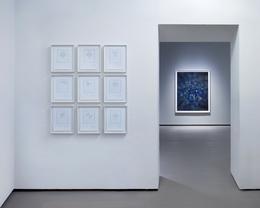
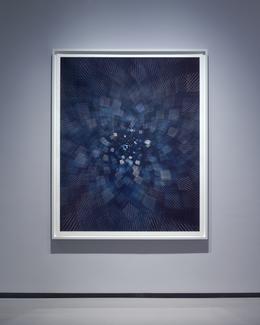
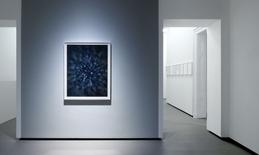
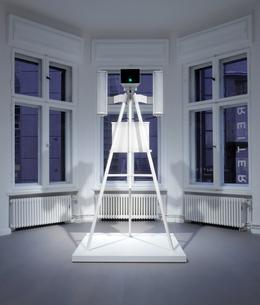
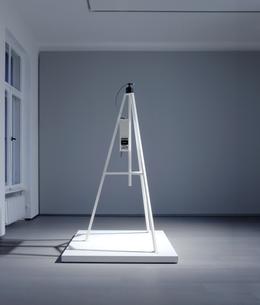
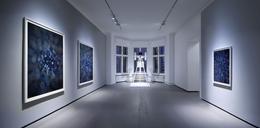
James Nizam’s distinctive sculptural approach to photography is grounded in a fundamental fascination with light itself, and thus his work is reflexively engaged with the essential nature of vision, perception and the photographic process. One could say that Nizam’s images concentrate on ‘that which allows us to see’: often portraying the sensual qualities of light structured by the creative use of key camera functions such as zoom, exposure and aperture. It is this enchantment of the elemental with the marvelous that allows his work to speak on profound levels.
Nizam has long explored the sculptural qualities of light as a ‘plastic’ element. For example, in “Frieze” (2016), successive beams of sunlight are pictured in a single photograph using timed exposures in a room-sized ‘camera obscura’ constructed in a derelict building. In “Pyramid”, “Thought Form (Icosohedron)” (both 2014) and other images, timed exposures reveal geometric figures constructed with reflected laser light within existing spaces. In these images, the light figures appear otherworldly against their architectural backgrounds, as if they were drawn or photoshopped in: what is compelling here is that the images are real.
This ethereal sensibility is powerfully evoked in the exhibition “Celestial Telegraphies”, which presents large scale prints produced in 2020 from the ongoing series “Drawing with Starlight”. In these photographs, starlight is depicted using a modified analog camera that employs timed exposures synchronized with the earth’s rotation to ‘draw’ with star-trails using a mechanically operated zoom. Not only do the long exposures render the ancient starlight in beautifully subtle grades of blue, the inventive camera movement creates a new aesthetic language across vast scales of time, space and emotion. Only possible to be captured during long new moon nights in remote locations and with extreme patience, the dedication required to construct these contemplative tableaus reflects the artist’s own insistence on a situated sense of wonder. Taken during expeditions under the night skies of the Canadian Rocky Mountains and the Canary Islands, Spain, the stellar formations are arrived at after exhaustive research, since these photos are only able to be seen and assessed later in the lab and not on location. Alongside six versions of “Drawing with Starlight”, each based on a unique graphic character, Nizam presents “Uranographic Figures”, a series of diagrammatic transcripts that map the time signatures used to calculate these iterative star motifs.
Codes of translation, transformation and re-mediation are conceptually important to Nizam, whose work frequently transfers sets of immaterial information between visible, sculptural, and audible media. For the previously shown work “Score” (2017), the artists used image-to-sound conversion software to sequence a ‘starlight drawing’ into morse code that was then pressed into white vinyl. Continuing the process of transference, Nizam used the reflective platinum vinyl stamper to create a series of sun flares across an abandoned quarry for the photograph “Heliographic Scale” (2017); further re-iterating the tautology of this information-aesthetic regime. The heliograph’s name comes from the Greek helios, “the sun,” and graphein “to write,” succinctly summarizing Nizam’s obsession with devices that consolidate light and language. For “Celestial Telegraphies”, the cosmic figures from “Drawing with Starlight” are translated into further codes; processed into both a 3D image and audio files that are used to produce further works.
“Beyond Violet” is a crystalline structure produced with information that represents an algorithmically treated translation of “Drawing with Starlight (Ogee)” with which it is presented alongside. The name “Ogee” refers to the formal similarity of this particular star-trail motif to an eponymous double curve that is characteristic of Gothic doorway shapes which, when digitally rendered and 3D printed, take on the form of a delicate double helix pattern of flower-like petals.
Using spectrographic conversion to sonify selected photographs from the “Drawing with Starlight” series creates similarly ‘serpentine’ and ‘geometric’ sounds, often producing the auditory illusion called the Shepard tone, a superposition of sine waves that gives the impression of continually ascending or descending in pitch. In a work that refers to Alexander Bell’s "photophone" (1880), a device that can send sound on a beam of sunlight, the sonofied stars are further encoded so that they can be carried by a laser beam, zigzagging from a transmitter across the gallery, between mirrors and on to a receiver where it is amplified. The resulting soundscape, heard throughout the gallery, returns the light of the stars as a path of light through the exhibition space. Transported and transporting, this droning ‘alien chant’ is both otherworldly and uncanny; a cipher for the interweaving of the cosmic and the intimate that “Celestial Telegraphies” arouses. If the “Drawing with Starlight” series fashions a figural language from imponderable star-trails, the star-source sustains a profound engagement as it’s delicate displacement from form to format echoes a parallel transformation in the viewer’s metaphysical associations.
The effect is of an intuitive apprehension of primordial energy across aesthetic and emotional dimensions, the significance of which is articulated by the dynamic relation of perception and observation to play-back, re-presentation and re-visualization. Through his indexical yet productive relation to the 'photographic', which Nizam allows spatial agency, the artist opens a conceptual portal for the reciprocal relation between transmitter and receiver. His work is truly an alchemical-like act of transformation, and yet it is through novel medial processes arrived at by lengthy trial and error that his works are folded into endlessly poetic constellations.
— Rodney LaTourelle, 2020
Nizam has long explored the sculptural qualities of light as a ‘plastic’ element. For example, in “Frieze” (2016), successive beams of sunlight are pictured in a single photograph using timed exposures in a room-sized ‘camera obscura’ constructed in a derelict building. In “Pyramid”, “Thought Form (Icosohedron)” (both 2014) and other images, timed exposures reveal geometric figures constructed with reflected laser light within existing spaces. In these images, the light figures appear otherworldly against their architectural backgrounds, as if they were drawn or photoshopped in: what is compelling here is that the images are real.
This ethereal sensibility is powerfully evoked in the exhibition “Celestial Telegraphies”, which presents large scale prints produced in 2020 from the ongoing series “Drawing with Starlight”. In these photographs, starlight is depicted using a modified analog camera that employs timed exposures synchronized with the earth’s rotation to ‘draw’ with star-trails using a mechanically operated zoom. Not only do the long exposures render the ancient starlight in beautifully subtle grades of blue, the inventive camera movement creates a new aesthetic language across vast scales of time, space and emotion. Only possible to be captured during long new moon nights in remote locations and with extreme patience, the dedication required to construct these contemplative tableaus reflects the artist’s own insistence on a situated sense of wonder. Taken during expeditions under the night skies of the Canadian Rocky Mountains and the Canary Islands, Spain, the stellar formations are arrived at after exhaustive research, since these photos are only able to be seen and assessed later in the lab and not on location. Alongside six versions of “Drawing with Starlight”, each based on a unique graphic character, Nizam presents “Uranographic Figures”, a series of diagrammatic transcripts that map the time signatures used to calculate these iterative star motifs.
Codes of translation, transformation and re-mediation are conceptually important to Nizam, whose work frequently transfers sets of immaterial information between visible, sculptural, and audible media. For the previously shown work “Score” (2017), the artists used image-to-sound conversion software to sequence a ‘starlight drawing’ into morse code that was then pressed into white vinyl. Continuing the process of transference, Nizam used the reflective platinum vinyl stamper to create a series of sun flares across an abandoned quarry for the photograph “Heliographic Scale” (2017); further re-iterating the tautology of this information-aesthetic regime. The heliograph’s name comes from the Greek helios, “the sun,” and graphein “to write,” succinctly summarizing Nizam’s obsession with devices that consolidate light and language. For “Celestial Telegraphies”, the cosmic figures from “Drawing with Starlight” are translated into further codes; processed into both a 3D image and audio files that are used to produce further works.
“Beyond Violet” is a crystalline structure produced with information that represents an algorithmically treated translation of “Drawing with Starlight (Ogee)” with which it is presented alongside. The name “Ogee” refers to the formal similarity of this particular star-trail motif to an eponymous double curve that is characteristic of Gothic doorway shapes which, when digitally rendered and 3D printed, take on the form of a delicate double helix pattern of flower-like petals.
Using spectrographic conversion to sonify selected photographs from the “Drawing with Starlight” series creates similarly ‘serpentine’ and ‘geometric’ sounds, often producing the auditory illusion called the Shepard tone, a superposition of sine waves that gives the impression of continually ascending or descending in pitch. In a work that refers to Alexander Bell’s "photophone" (1880), a device that can send sound on a beam of sunlight, the sonofied stars are further encoded so that they can be carried by a laser beam, zigzagging from a transmitter across the gallery, between mirrors and on to a receiver where it is amplified. The resulting soundscape, heard throughout the gallery, returns the light of the stars as a path of light through the exhibition space. Transported and transporting, this droning ‘alien chant’ is both otherworldly and uncanny; a cipher for the interweaving of the cosmic and the intimate that “Celestial Telegraphies” arouses. If the “Drawing with Starlight” series fashions a figural language from imponderable star-trails, the star-source sustains a profound engagement as it’s delicate displacement from form to format echoes a parallel transformation in the viewer’s metaphysical associations.
The effect is of an intuitive apprehension of primordial energy across aesthetic and emotional dimensions, the significance of which is articulated by the dynamic relation of perception and observation to play-back, re-presentation and re-visualization. Through his indexical yet productive relation to the 'photographic', which Nizam allows spatial agency, the artist opens a conceptual portal for the reciprocal relation between transmitter and receiver. His work is truly an alchemical-like act of transformation, and yet it is through novel medial processes arrived at by lengthy trial and error that his works are folded into endlessly poetic constellations.
— Rodney LaTourelle, 2020
Artists